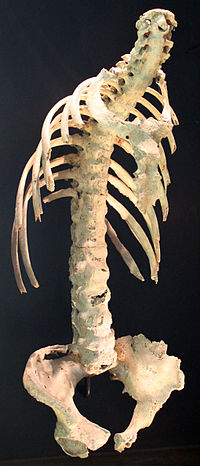
Photo from wikipedia
Abstract To retrospectively evaluate initial tumor necrosis factor inhibitor (TNFi) failure patients for clinical predictors of response to a 2nd TNFi in our 4282 rheumatoid arthritis (RA) patient database. A… Click to show full abstract
Abstract To retrospectively evaluate initial tumor necrosis factor inhibitor (TNFi) failure patients for clinical predictors of response to a 2nd TNFi in our 4282 rheumatoid arthritis (RA) patient database. A cross-sectional retrospective manual chart review of the electronic health record (EHR) was performed on 322 “real world” RA patients who were prescribed 2 TNFis. Response to TNFi was determined by the treating provider who had real time Clinical Disease Activity Index (CDAI) scores to inform treatment decisions. Age, gender, body mass index (BMI), insurance provider, duration of disease, cyclic citrullinated peptide antibody (CCP) and rheumatoid factor (RF) positivity, concomitant disease modifying anti-rheumatic drug therapy, length of time between diagnosis and start of 1st and 2nd TNFi, transient efficacy of 1st TNFi (defined as response to TNFi at 3 months but later lost response), and reason for discontinuation of 1st TNFi were analyzed. A multivariable logistic regression model was used to model response to a 2nd TNFi. Response proportions to the 2nd TNFi were greater in females (161/223, 72.2% response female vs 41/75, 54.7% male, P < .01), those who began their 1st TNFi within 3 months of their RA diagnosis, and in RF+ patients (123/170, 72.4% response seropositive vs 66/110, 60.0% seronegative, P < .03). The higher female response rate was independent of age, BMI, and seropositivity. In RA patients who failed an initial TNFi, female patients and patients with RF+ were more likely to have a clinical response to a 2nd TNFi. In the absence of these predictors, stronger consideration for choosing a biologic with an alternative mechanism of action might be given when the 1st TNFi fails.
Journal Title: Medicine
Year Published: 2020
Link to full text (if available)
Share on Social Media: Sign Up to like & get
recommendations!